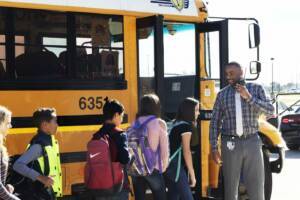
School buses have unique challenges that have to be met. In California, state law requires that there be a two-way radio in every school bus. Having a radio that provides communications around the school district is often easy, but in many school districts, the terrain provides challenges that make the communications with the school buses a difficult challenge to resolve.
Cellular is unreliable in many circumstances, especially when the calls go to voice mail. The ability to speak with any or all of the ambulance fleet at one time at the push of a button cannot be replicated by cellular. Cellular is expensive for several reasons:
- State law prohibits the use of handheld electronic devices while driving which include cellular telephones unless connected to a Bluetooth or other hands free device. Hands free devices do not work well in environments that have background noise like in the cab of a truck, bus or other large vehicle.
- Kenwood white paper regarding new law affecting mobile device use by commercial drivers does not affect two-way radio.
- The initial cost of smart phones is high and the reliability is low
- Cellular phones often need to be rebooted
- Missed calls end up going to voice mail which significantly delays message throughput
- Cellular phones almost always fail during a major emergency
- Cellular systems become instantly overloaded during a major emergency
- It takes too long to dial, wait for the phone to ring and receive an answer compared to Push-To-Talk with two-way radio.
- Only 2-3 people can discuss an issue at the same time with cellular. With two-way radio, any size group of people can be part of the same conversation
There are many solutions that are simple to institute such as a conventional repeater. However, the repeater often does not provide coverage over the entire school district, so 2 or 3 repeaters are installed to provide coverage. With conventional systems there is typically manual switching between repeaters and this leads to driver confusion as well as considerable training issues.
School radios are used primarily for student transportation to school and from school. School buses are also used for field trips for students to museums, science centers, other schools, etc. One of the big uses of school buses is for student athletic competition, often between different school districts. This necessitates coverage within the school district and also requires coverage outside the school district.
A new state law requires school bus operators to have a button at the back of every school bus that must be pressed before the driver parks and exits the vehicle. This is due to an accident that occurred with Pupil Transportation in 2015 where a mentally challenged student fell asleep on the bus and did not exit the bus at his designated bus stop. When the driver was done for the day, the driver parked the bus, closed it up and left the vehicle. It was a hot day and the student who fell asleep on the bus died from dehydration. Every school bus must implement a system that requires the driver to press a button at the back of the bus, forcing the driver to walk the entire length of the bus to press the button. Failure to press the button will set off an alarm if the button is not pressed before the engine is shut off. The MRA Diga-Talk Network can provide the required notification to the school bus operator when the radio is equipped with a special package from Datalink Systems, Inc. which includes the button at the back of the bus.
All of these needs can be accommodated by our Digi-Talk network to provide reliable on site communications within the district and reliable wide area communications over Southern California. Often school bus personnel would benefit from being able to take their radio home to facilitate communications with other personnel who are on the job working. This is easily accomplished with Diga-Talk while it could be difficult to impossible to accomplish with any network that could be purchased and installed by a school bus operator or school district.
In both of the presentations below, there are many interactive features in the presentation by clicking on the arrows.
Click here to view an interactive presentation on Communications Solutions for Education.
Click here to view an interactive presentation on Communications Solutions for Transportation.
Try our Diga-Talk radios with the following great features:
- Loud and clear quality audio that can be heard under loud noise conditions with Kenwood’s noise reduction technology
- Quick access to your personnel – connection time is typically 1.0 second or less
- GPS tracking can tell you where your crew are located
- Eliminate the distraction and illegal use of cellular while driving
- The liability associated with a driver getting into an accident while using a cellular device can cost a company far in excess the cost of a two-way radio system
Remember the 3 rules of making money in real estate, Location, Location and Location. The 3 Cs of radio communications are Coverage, Coverage and more Coverage. Our customers demand coverage. Every school bus operator has their own need for coverage which is never exactly the same as another school bus operator. By providing more coverage in Southern California than any other radio company, we can provide solutions when the others can’t do it. By adding a network site within your district, we can provide superb local coverage and excellent wide area coverage. Read more…
Schedule a free demo